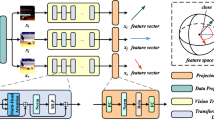Abstract
It is the main task of visual anomaly detection to find local regions whose saliency is inconsistent with normal appearance. However, existing mainstream anomaly detection models suffer from low detection accuracy and poor generalization performance. Therefore, this paper designs an unsupervised surface anomaly detection model based on attention and atrous spatial pyramid pooling. The proposed model learns anomaly images and their normal reconstruction and simultaneously learns the decision boundaries of normal and anomaly images. The method utilizes a squeeze-and-excitation block to assign attention to feature channels to improve the sensitivity of related favorable features, thus enhancing the model’s ability to learn normal and anomaly boundaries. In addition, atrous spatial pyramid pooling is introduced in the discriminative sub-network to obtain the multi-scale semantic information of the training image, which improves the detection ability of defects of different sizes and enhances the universality of the model. The superiority of our method is demonstrated in the anomaly detection benchmark MVTec dataset.
Access this chapter
Tax calculation will be finalised at checkout
Purchases are for personal use only
Similar content being viewed by others
References
Li, S.B., Yang, J., Wang, Z.: Review of development and application of defect detection technology. Acta Automatica Sinica 46(11), 2319–2336 (2020)
Wu, C., Li, W.: Enhancing intrusion detection with feature selection and neural network. Int. J. Intell. Syst. 36(7), 3087–3105 (2021)
Yan, H., Chen, M., Hu, L., Jia, C.: Secure video retrieval using image query on an untrusted cloud. Appl. Soft Comput. 97, 106782 (2020)
Fang, M., Jin, Z., Qin, F., Peng, Y., Jiang, C., Pan, Z.: Re-transfer learning and multi-modal learning assisted early diagnosis of Alzheimer’s disease. Multimedia Tools Appl. 81, 29159–29175 (2022). https://doi.org/10.1007/s11042-022-11911-6
Mei, S., Yang, H., Yin, Z.: An unsupervised-learning-based approach for automated defect inspection on textured surfaces. IEEE Trans. Instrum. Meas. 67(6), 1266–1277 (2018)
Bergmann, P., Fauser, M., Sattlegger, D., et al.: MVTec AD–a comprehensive real-world dataset for unsupervised anomaly detection. In: Proceedings of the IEEE/CVF Conference on Computer Vision and Pattern Recognition, pp. 9592–9600 (2019)
Xia, X., Pan, X., He, X.: Discriminative-generative representation learning for one-class anomaly detection (2021)
Perera, P., Nallapati, R., Bing, X.: OCGAN: one-class novelty detection using GANs with constrained latent representations. In: 2019 IEEE/CVF Conference on Computer Vision and Pattern Recognition, pp. 2898–2906 (2019)
Hou, J., Zhang, Y., Zhong, Q., et al.: Divide-and-assemble: learning block-wise memory for unsupervised anomaly detection. In: Proceedings of the IEEE/CVF International Conference on Computer Vision, pp. 8791–8800 (2021)
Rippel, O., Mertens, P., Merhof, D.: Modeling the distribution of normal data in pre-trained deep features for anomaly detection. In: 2020 25th International Conference on Pattern Recognition, pp. 6726–6733 (2021)
Defard, T., Setkov, A., Loesch, A., Audigier, R.: PaDiM: a patch distribution modeling framework for anomaly detection and localization. In: Del Bimbo, A., Cucchiara, R., Sclaroff, S., Farinella, G.M., Mei, T., Bertini, M., Escalante, H.J., Vezzani, R. (eds.) ICPR 2021. LNCS, vol. 12664, pp. 475–489. Springer, Cham (2021). https://doi.org/10.1007/978-3-030-68799-1_35
Rudolph, M., Wandt, B., Rosenhahn, B.: Same same but DifferNet: semi-supervised defect detection with normalizing flows. In: Proceedings of the IEEE/CVF Winter Conference on Applications of Computer Vision, pp. 1907–1916. (2021)
Zavrtanik, V., Kristan, M., Skočaj, D.: DRAEM-a discriminatively trained reconstruction embedding for surface anomaly detection. In: Proceedings of the IEEE/CVF International Conference on Computer Vision, pp. 8330–8339 (2021)
Hu, J., Shen, L., Sun, G.: Squeeze-and-excitation networks. In: Proceedings of the IEEE Conference on Computer Vision and Pattern Recognition, pp. 7132–7141 (2018)
Chen, LC., Papandreou, G., Kokkinos, I.: Semantic image segmentation with deep convolutional nets and fully connected CRFs. In: International Conference on Learning Representations, pp. 357–361 (2014)
Lin, T.Y., Goyal, P., Girshick, R., et al.: Focal loss for dense object detection. In: Proceedings of the IEEE International Conference on Computer Vision, pp. 2980–2988 (2017)
Cimpoi, M., Maji, S., Kokkinos, I.: Describing textures in the wild. In: Proceedings of the IEEE Conference on Computer Vision and Pattern Recognition, pp. 3606–3613 (2014)
Akcay, S., Atapour-Abarghouei, A., Breckon, T.P.: GANomaly: semi-supervised anomaly detection via adversarial training. In: Jawahar, C.V., Li, H., Mori, G., Schindler, K. (eds.) ACCV 2018. LNCS, vol. 11363, pp. 622–637. Springer, Cham (2019). https://doi.org/10.1007/978-3-030-20893-6_39
Bergmann, P., Fauser, M., Sattlegger, D., Steger C.: Uninformed students: student-teacher anomaly detection with discriminative latent embeddings. In: Proceedings of the IEEE/CVF Conference on Computer Vision and Pattern Recognition, pp. 4183–4192 (2020)
Acknowledgments
This paper is supported by the National Natural Science Foundation of China, under Grant No. 62162026, the Science and Technology Key Research and Development Program of Jiangxi Province, under Grant No. 20202BBEL53004 and Science and Technology Project supported by Education Department of Jiangxi Province, under Grant No. GJJ210611.
Author information
Authors and Affiliations
Corresponding author
Editor information
Editors and Affiliations
Rights and permissions
Copyright information
© 2023 The Author(s), under exclusive license to Springer Nature Switzerland AG
About this paper
Cite this paper
Huang, Y., Xie, X., Ning, W., Wu, D., Li, Z., Yang, H. (2023). An Unsupervised Surface Anomaly Detection Method Based on Attention and ASPP. In: Xu, Y., Yan, H., Teng, H., Cai, J., Li, J. (eds) Machine Learning for Cyber Security. ML4CS 2022. Lecture Notes in Computer Science, vol 13656. Springer, Cham. https://doi.org/10.1007/978-3-031-20099-1_16
Download citation
DOI: https://doi.org/10.1007/978-3-031-20099-1_16
Published:
Publisher Name: Springer, Cham
Print ISBN: 978-3-031-20098-4
Online ISBN: 978-3-031-20099-1
eBook Packages: Computer ScienceComputer Science (R0)




